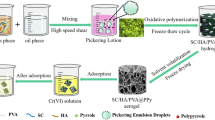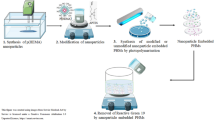Abstract
Unique polypyrrole (PPy) hydrogels are prepared by using orange IV as the dopant and FeCl3 as the oxidant. The static polymerization of pyrrole monomer in aqueous solution is accompanied with self-assembly of PPy hydrogel. PPy hydrogels not only show good electrical conductivities, but also exhibit excellent water-absorbent behaviors. The macroscopic appearance, microscopic morphology and water-absorbent behaviors of PPy hydrogels can be controlled by the choice of the reaction condition. The effects of ionic strength on the physical properties of PPy hydrogels are also studied. The results indicate that PPy hydrogels show improved water absorbencies in saline solution. Moreover, PPy hydrogel is used as an efficient adsorbent to remove Cr(VI) from aqueous solutions. PPy hydrogel exhibits much better adsorption performance than common PPy nanoparticles. This kind of PPy hydrogel is expected to be a potential candidate for water treatment.









Similar content being viewed by others
References
Zhang X, Goux WJ, Manohar SK (2004) Synthesis of polyaniline nanofibers by nanofiber seeding. J Am Chem Soc 126:4502–4503
Sirivisoot S, Pareta R, Webster T, Webster J (2011) Electrically controlled drug release from nanostructured polypyrrole coated on titanium. Nanotechnology 22:085101
Dumanli AG, Erden A, Yurum Y (2012) Development of supercapacitor active composites by electrochemical deposition of polypyrrole on carbon nanofibres. Polym Bull 68:1395–1404
Tsai TS, Pillay V, Choonara YE, du Toit LC, Modi G, Naidoo D, Kumar P (2011) A polyvinyl alcohol-polyaniline based electro-conductive hydrogel for controlled stimuli-actuable release of indomethacin. Polymers 3:150–172
Brahim S, Narinesingh D, Guiseppi-Elie A (2002) Bio-smart hydrogels: co-joined molecular recognition and signal transduction in biosensor fabrication and drug delivery. Biosens Bioelectron 17:973–981
da Silva LBJ, Orefice RL (2014) Synthesis and electromechanical actuation of a temperature, pH, and electrically responsive hydrogel. J Polym Res 21:466
Kim SJ, Kim MS, Kim SI, Spinks GM, Kim BC, Wallace GG (2006) Self-oscillatory actuation at constant DC voltage with pH-sensitive chitosan/polyaniline hydrogel blend. Chem Mater 18:5805–5809
Marcasuzaa P, Reynaud S, Ehrenfeld F, Khoukh A, Desbrieres J (2010) Chitosan-graft-polyaniline-based hydrogels: elaboration and properties. Biomacromolecules 11:1684–1691
Guo B, Finne-Wistrand A, Albertsson AC (2011) Degradable and electroactive hydrogels with tunable electrical conductivity and swelling behavior. Chem Mater 23:1254–1262
Blinova NV, Trchova M, Stejskal J (2009) The polymerization of aniline at a solution-gelatin gel interface. Eur Polymer J 45:668–673
Xiao Y, He L, Che J (2012) An effective approach for the fabrication of reinforced composite hydrogel engineered with SWNTs, polypyrrole and PEGDA hydrogel. J Mater Chem 22:8076–8082
Xu XH, Ren GL, Cheng J, Liu Q, Li DG, Chen Q (2006) Self-assembly of polyaniline-grafted chitosan/glucose oxidase nanolayered films for electrochemical biosensor applications. J Mater Sci 41:4974–4977
Du R, Xu Y, Luo Y, Zhang X, Zhang J (2011) Synthesis of conducting polymer hydrogels with 2D building blocks and their potential-dependent gel-sol transitions. J Chem Soc Chem Commun 47:6287–6289
Chen L, Kim BS, Nishino M, Gong JP, Osada Y (2000) Environmental responses of polythiophene hydrogels. Macromolecules 33:1232–1236
Mawad D, Stewart E, Officer DL, Romeo T, Wagner P, Wagner K, Wallace GG (2012) A single component conducting polymer hydrogel as a scaffold for tissue engineering. Adv Funct Mater 22:2692–2699
Dai T, Jiang X, Hua S, Wang X, Lu Y (2008) Facile fabrication of conducting polymer hydrogels via supramolecular self-assembly. J Chem Soc Chem Commun 36:4279–4281
Wei D, Lin X, Li L, Shang S, Yuen MC, Yan G, Yu X (2013) Controlled growth of polypyrrole hydrogels. Soft Matter 9:2832–2836
Pepin-Donat B, Viallat A, Blachot JF, Lombard C (2006) Electromechanical polymer gels combining rubber elasticity with electronic conduction. Adv Mater 18:1401–1405
Tang Q, Wu J, Lin J (2008) A multifunctional hydrogel with high conductivity, pH-responsive, thermo-responsive and release properties from polyacrylate/polyaniline hybrid. Carbohydr Polym 73:315–321
Li M, Guo Y, Wei Y, MacDiarmid AG, Lelkes PI (2006) Electrospinning polyaniline-contained gelatin nanofibers for tissue engineering applications. Biomaterials 27:2705–2715
Talens-Alesson FI, Anthony S, Bryce M (2004) Complexation of organic compounds in the presence of Al3+ during micellar flocculation. Water Res 38:1477–1483
Romero A, Cascales J, Otero TF (2005) In situ FTIR spectroscopy study of the break-in phenomenon observed for PPy/PVS films in acetonitrile. J Phys Chem B 109:21078–21085
Bohidar HB, Dubin P, Osada Y (2002) Polymer gels: fundamentals and applications. Am Chem Soc, Washington DC
Flory PJ (1953) Principles of polymer chemistry. Cornell University Press, Ithaca
Castel D, Ricard A, Audebert R (1990) Swelling of anionic and cationic starch-based superabsorbents in water and saline solution. J Appl Polym Sci 39:11–29
Kampalanonwat P, Supaphol P (2010) Preparation and adsorption behavior of aminated electrospun polyacrylonitrile nanofiber mats for heavy metal ion removal. ACS Appl Mater Interfaces 2:3619–3627
Basso MC, Cerrella EG, Cukierman AL (2002) Lignocellulosic materials as potential biosorbents of trace toxic metals from wastewater. Ind Eng Chem Res 41:3580–3585
Bhaumik M, Maity A, Srinivasu VV, Onyango MS (2011) Enhanced removal of Cr(VI) from aqueous solution using polypyrrole/Fe3O4 magnetic nanocomposite. J Hazard Mater 190:381–390
Acknowledgments
The work was supported by Graduate Innovative Fund of Wuhan Institute of Technology (No. CX2014059), Outstanding Youth Scientific Innovation Team of Colleges and Universities in Hubei Province (T201406), Outstanding Youth Scientific Foundation of Hubei Province (2012FFA021), National Natural Science Foundation of China (51403167, 51374155) and Science and Technology Support Program of Hubei Province (2014BCB034).
Author information
Authors and Affiliations
Corresponding author
Rights and permissions
About this article
Cite this article
Li, S., Liu, J., Zhang, X. et al. Assembly of conducting polypyrrole hydrogels as a suitable adsorbent for Cr(VI) removal. Polym. Bull. 72, 2891–2902 (2015). https://doi.org/10.1007/s00289-015-1442-0
Received:
Revised:
Accepted:
Published:
Issue Date:
DOI: https://doi.org/10.1007/s00289-015-1442-0




